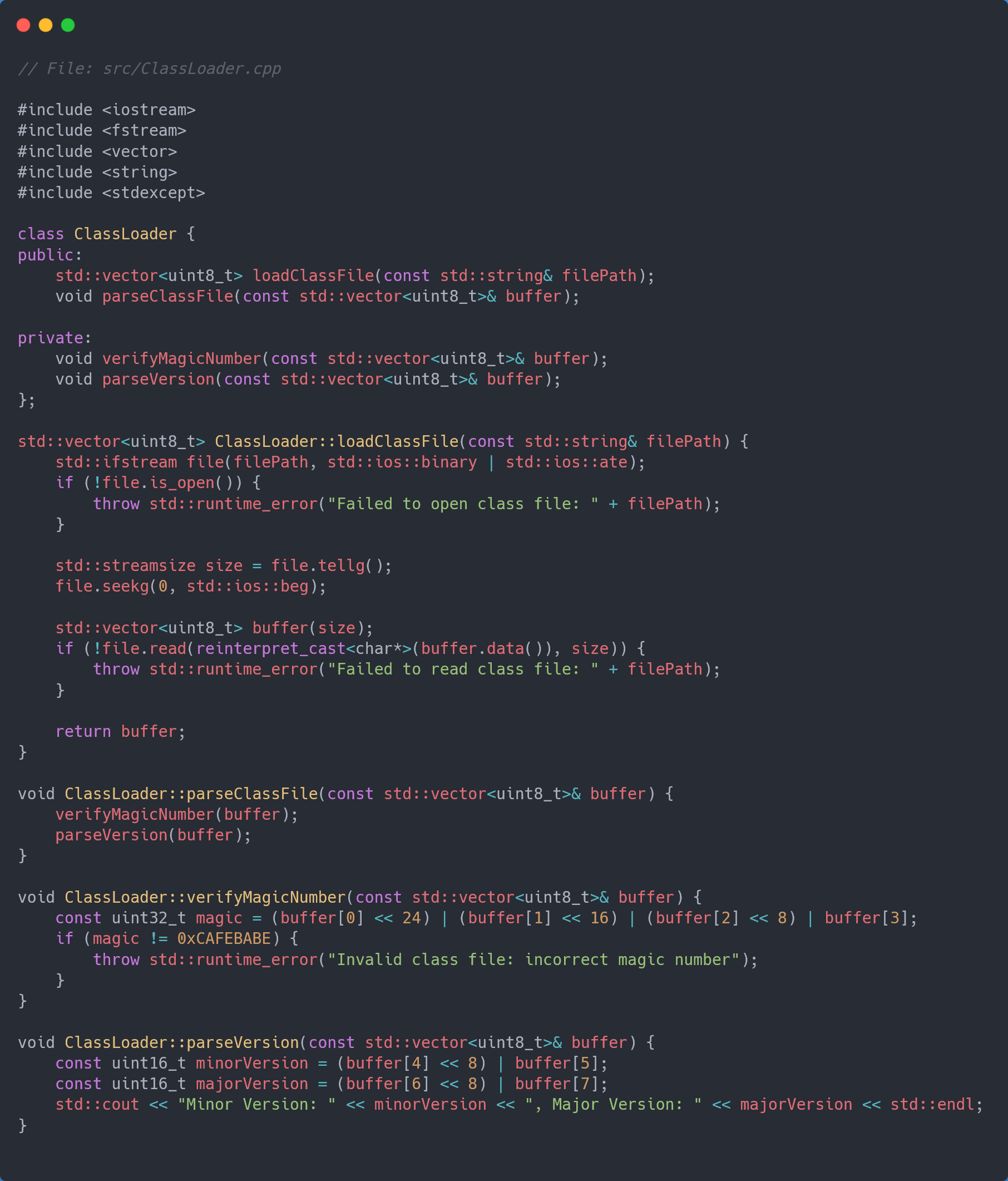Creating a Java Virtual Machine in C++ (Again) - part #1

The first implementation of CVM (in C):
CVM/archiveThe WIP re-implementation of CVM a.k.a CVM++ (in C++):
CVM/dev
The CVM++
About a year ago, I decided to write a JVM in C — and I did.
It just wasn’t quite what I wanted and it lacked many functions. Actually, I wrote a Java debugger on a binary level rather than a full JVM.
A year later, I decided to look at this project again and give it the functionality it deserves.
This time, I stepped out of my comfort zone and did it in C++ instead of C (also, I’m too old to deal with string manipulation in C anymore).
I believe this series will be quite long and useful for both Java and C++ programmers.
Welcome to the first part.
The Functional Requirements
Since I didn’t want to make the same mistakes as last time, I started by writing down the functional requirements of the JVM I wanted to create.
The software I’ll build throughout this series will have the following functional requirements:
- Class loading
- Load classes from the file system.
- Resolve symbolic references.
- Bytecode verification
- Verify bytecode integrity to prevent security vulnerabilities.
- Perform structural and behavioral checks on bytecode instructions.
- Runtime Data Areas
- Implement runtime data areas such as heap, method area, program counter (PC), stack, and native method stacks.
- Manage memory allocation and deallocation.
- Handle thread-local storage for each thread executing on the JVM.
- Execution Engine
- Interpret bytecode instructions or use JIT for performance optimization.
- Support execution of Java bytecode according to the JVM spec.
- Implement core instructions like load/store, arithmetic, flow control, method invocation, and exception handling.
Of course, a production-ready JVM would have far more features.
But my goal here is simply to make a working JVM — it doesn’t have to be production-grade.
What is the .class file?
A .class file is a binary format used by the Java language to store compiled bytecode.
When you compile a Java source file (.java), the Java compiler (javac) generates a .class file for each class defined in the source.
Structure of .class
A .class file follows the JVM Specification.
Here’s a brief overview:
- Magic Number:
First 4 bytes =0xCAFEBABE, identifying a valid class file. - Version Info:
Next 4 bytes represent minor and major compiler version. - Constant Pool:
A table of constants (strings, numbers, references). - Access Flags:
Two bytes defining access permissions and class properties. - This / Super Class:
Indices into the constant pool for current class and superclass. - Interfaces, Fields, Methods, Attributes:
Definitions of interfaces implemented, declared fields, and methods.
Purpose of .class
.class files serve as the intermediary between Java source and the JVM.
They contain platform-independent bytecode, which any JVM can execute.
When you run a Java program, the JVM loads the .class files, interprets the bytecode, and executes the instructions.
A Humble Goal

My modest goal is this:
I’ll write a very small Java program and my own JVM will run it.
For this, I created a structure like this:
├── CMakeLists.txt
├── CONTRIBUTING.md
├── Dockerfile
├── LICENSE
├── Makefile
├── PULL_REQUEST_TEMPLATE.md
├── README.md
├── cmake/
│ ├── CVMConfig.cmake.in
│ ├── CompilerWarnings.cmake
│ ├── Conan.cmake
│ ├── Doxygen.cmake
│ ├── SourcesAndHeaders.cmake
│ ├── StandardSettings.cmake
│ ├── StaticAnalyzers.cmake
│ ├── Utils.cmake
│ └── version.hpp.in
├── codecov.yaml
├── docs/banner.jpg
├── include/cvm/
│ ├── fmt_commons.hpp
│ └── tmp.hpp
├── sample/
│ ├── Add.class
│ └── Add.java
├── src/
│ ├── main.cpp
│ └── tmp.cpp
└── test/
├── CMakeLists.txt
└── src/tmp_test.cpp
I thought it was a modern and versatile project structure,
so I started by writing the Java code I wanted to run:
public class Add {
public static int add(int a, int b) {
return a + b;
}
}
As you can see, it’s a very simple program.
Then I compiled it with javac, creating the .class file.
The hexdump of the .class file
00000000: cafe babe 0000 0042 000f 0a00 0200 0307 .......B........
00000010: 0004 0c00 0500 0601 0010 6a61 7661 2f6c ..........java/l
00000020: 616e 672f 4f62 6a65 6374 0100 063c 696e ang/Object...<in
00000030: 6974 3e01 0003 2829 5607 0008 0100 0341 it>...()V......A
00000040: 6464 0100 0443 6f64 6501 000f 4c69 6e65 dd...Code...Line
00000050: 4e75 6d62 6572 5461 626c 6501 0003 6164 NumberTable...ad
00000060: 6401 0005 2849 4929 4901 000a 536f 7572 d...(II)I...Sour
00000070: 6365 4669 6c65 0100 0841 6464 2e6a 6176 ceFile...Add.jav
00000080: 6100 2100 0700 0200 0000 0000 0200 0100 a.!.............
00000090: 0500 0600 0100 0900 0000 1d00 0100 0100 ................
000000a0: 0000 052a b700 01b1 0000 0001 000a 0000 ...*............
000000b0: 0006 0001 0000 0001 0009 000b 000c 0001 ................
000000c0: 0009 0000 001c 0002 0002 0000 0004 1a1b ................
000000d0: 60ac 0000 0001 000a 0000 0006 0001 0000 `...............
000000e0: 0003 0001 000d 0000 0002 000e ............
We’ll do a detailed review of this hexdump in the next part of the series.
But notice the cafe babe at the beginning — the magic number verifying this is a .class file.
Maybe I’ll tell its story someday.
After this point, I had a .class file.
All that remained was loading and parsing it — guided by the Oracle JVM Specification.
The ClassLoader
Here’s my base class loader class:

I started the project with this simple loader.
Its purpose is to load a .class file compiled with javac into memory and validate it.
std::vector<uint8_t> loadClassFile(const std::string& filePath)— Loads a class file from disk into memory.void parseClassFile(const std::vector<uint8_t>& buffer)— Parses the contents of the class buffer.
Thanks to this class, I could import .class files and start processing them.
We’ll examine their structure in the next part of the series.
Until then — goodbye.
